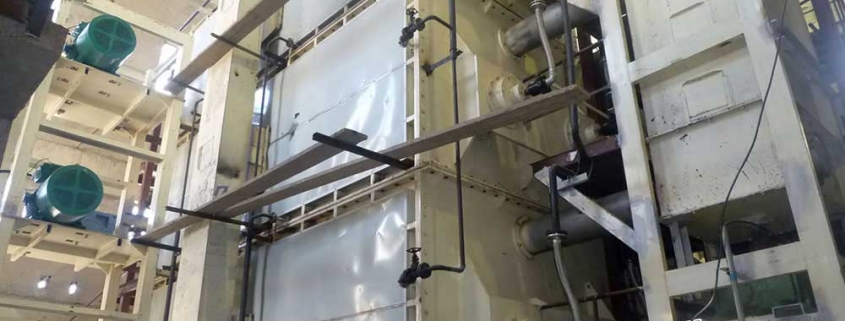There are a variety of drying equipment on the market. In order to better understand the drying equipment, we will briefly introduce the common types of drying equipment. We all know that the drying process of drying equipment requires a lot of heat energy. In order to save energy, some materials with high moisture content, suspensions or solutions containing solid substances are generally first mechanically dehydrated or heated and evaporated, and then dried in a desiccator. To get a dry solid. In the drying process, the heat and mass (moisture) transfer must be completed at the same time, which can ensure that the moisture partial pressure (concentration) of the material surface is higher than the moisture partial pressure partial pressure in the external space, and then the heat source temperature is higher than the material temperature.
By transferring heat from the high-temperature heat source to the wet material in various ways, the surface of the material can be vaporized and dispersed into the external space, so that the difference in moisture content occurs on the surface and inside of the material. The internal moisture partition diffuses and vaporizes to the surface, so that the moisture content of the material is continuously reduced, and the overall drying of the material is gradually completed. The rate of drying of the material depends on the rate of surface vaporization and the rate of diffusion of the internal moisture. Generally, the drying rate in the early drying stage is controlled by the surface vaporization rate. As long as the external conditions of drying are constant, the drying rate and surface temperature of the material are kept stable. This stage is called the constant-speed drying stage. When the moisture content of the material is reduced to a certain extent. When the internal moisture distribution to the surface is reduced, and the surface vaporization rate is lower than the surface vaporization rate, the drying rate is mainly determined by the internal diffusion rate, and is continuously decreased as the moisture content is lowered. This stage is called the slow-down drying stage. In addition, technological advances will reverse the current export situation of domestic drying equipment.
Drying equipment type
There are many types of drying equipment for drying operations. According to the operating pressure, it can be divided into normal pressure and decompression (also known as vacuum dryer), which can be selected according to your own needs; it can be divided into batch and continuous according to the operation method; Air, flue gas or other drying medium; according to the movement (material movement and drying medium flow) can be divided into co-current, countercurrent and cross-flow, etc., but the common drying equipment mainly has the following categories, let’s take a look at it. .
(1) Slime dryer
The slime sludge of the slime dryer with moisture content of 25~40% is firstly dispersed by the special feeding device and then transported to the feeder by the belt feeder, and then the wet coal slurry is transported by the feeder. In the drying drum, the coal slurry is evenly distributed under the rolling plate of the drying drum, and is evenly dispersed and fully contacted with the hot air to achieve the purpose of drying heat and mass transfer.
(2) Belt dryer
It consists of several independent unit segments. Each unit section includes a circulating fan, a heating unit, a separate or common fresh air intake system, and an exhaust system. The operating parameters of the amount of drying medium, temperature, humidity and exhaust gas circulation can be independently controlled to ensure the reliability of the working with the dryer and the optimization of operating conditions.
(3) Roller scraper dryer
The drum scraper dryer is a continuous operation device for drying a liquid material or a belt material attached to the outer wall of the cylinder by means of a rotating cylinder by heat conduction. The liquid to be dried is flowed from the high level tank into the receiving tank of the drum dryer. The drying drum is driven by the transmission and rotates at a specified speed.
(4) Hollow blade dryer (blade dryer)
The hollow blade dry dryer, also known as the blade dryer, is mainly composed of a W-shaped casing with a jacket and two hollow blade shafts and a transmission device. Hollow blades are arranged on the shaft, and the rotary end of the heat medium is introduced at the shaft end. The heat required to dry the moisture is conducted to the material by the inner wall of the jacketed W-shaped groove and the hollow blade wall.
(5) Vacuum kneading dryer
The dry material is added from the upper part of the top of the vacuum squeezing dryer. When the material is in contact with the shell wall under the stirring of the rotating dent, the surface is continuously updated, and the dried material is subjected to steam (or hot water, heat transfer oil). Indirect heating, but the moisture of the material vaporizes, and the vaporized water is pumped away by the vacuum pump in time. The material to be dried is indirectly heated by the heat carrier to vaporize the water in the material, and the vaporized water is discharged by the vacuum pump in time.
(6) Double cone rotary vacuum dryer
Double cone rotation The vacuum drying body is slightly olive-shaped with a cover at both ends and two shafts in the middle to support the body. The body has a jacket for heating, and the body can be rotated when dry, so that the material and the wall are frequently replaced, which overcomes the disadvantage that the material in the vacuum oven is mainly guided by the heating cylinder and has low thermal efficiency.
(7) Vacuum oven
Since the evaporation temperature of the volatiles contained in the evaporation of the material can be reduced after decompression, it is suitable for drying various heat-sensitive and easily oxidizable materials. This device is usually a cylinder or other vacuum-operated outer casing. It is heated by electric heating or hot water or heat-conducting oil through a heating plate or a heating pipe, and is suitable for batch production in small batches.
(8) Freeze dryer
In the freeze dryer, the liquid is first cooled and frozen, and then the pressure is reduced to sublimate the ice to obtain a dry material. Since the whole process is carried out below freezing point, it is often used for drying of heat sensitive articles. It is difficult to heat the frozen material under vacuum, and a large refrigeration system is required to condense the sublimated water vapor under reduced pressure, so the drying cost is large.
The moisture in the highly heat sensitive material is frozen and will be maintained at a temperature below freezing below under high vacuum. The water is sublimed to separate from the material. There is less loss of active ingredient in the material, but the drying rate is low.



